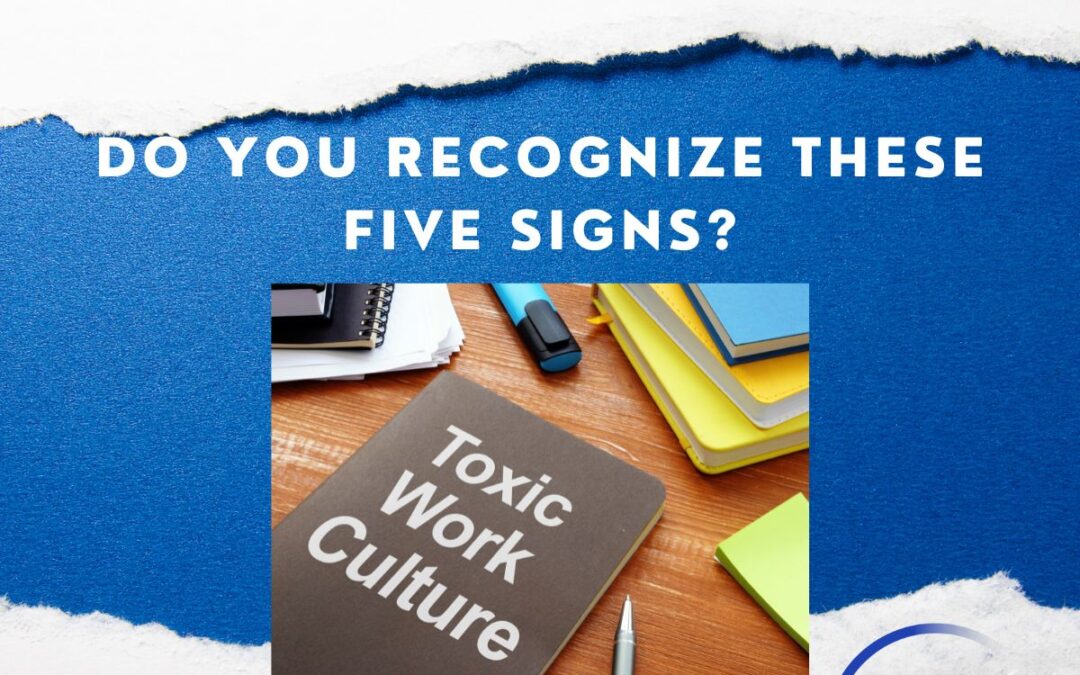“Culture eats strategy for breakfast.” Peter Drucker
If you are currently working in a larger organization, or even if you only have a small team, this is a topic worth considering. Many times we tend to focus so much on strategy within business to meet revenue goals, we often overlook the importance of culture. Fostering a positive and healthy workplace culture is not only crucial, if might be considered the number one driver of organizational success. However, some workspaces can become toxic, negatively impacting employee and team morale, productivity, and overall well-being. Recognizing the signs of a toxic culture is the first step towards addressing and rectifying the situation. See if you recognize any of these 5 signs below.
Signs of a Toxic Workplace Culture
1. High Turnover Rates: Constant revolving leadership and frequent employee departures may indicate underlying issues within the workplace culture.
2. Lack of Transparency: When communication channels are murky, and decisions are made behind closed doors, it fosters distrust and uncertainty among employees.
3. Micromanagement: Overbearing supervision and micromanagement stifle autonomy and creativity, leading to disengagement and frustration among employees.
4. Negative Office Politics: Gossip, favoritism, and office politics create a toxic environment characterized by mistrust and division among team members.
5. Fear of Speaking Up: In environments where employees fear retaliation or dismissal for voicing concerns or offering suggestions, innovation and collaboration suffer.
Solutions for a Positive Workplace Culture
There is some good news…with some feedback, time, and motivation to change the above issues, both leaders and employees can help turn culture around. Here’s how:
Lead by Example
Leaders play a pivotal role in shaping workplace culture. They should demonstrate the values and behaviors they expect from their employees. This includes practicing open communication, accountability, and integrity in all interactions. By modeling positive behaviors, leaders set the tone for the entire organization and inspire employees to follow suit.
Prioritize Communication
Effective communication is the foundation of a healthy workplace culture. Leaders should foster an environment where open dialogue is encouraged, and feedback is valued. Regular team meetings, one-on-one check-ins, and anonymous feedback mechanisms can facilitate communication and ensure that employees feel heard and respected. Transparent communication about company goals, challenges, and decisions helps build trust and alignment among team members.
Promote Work-Life Decision Making
Many employees often struggle to maintain healthy work-life decision making. Leaders should recognize the importance of allowing employees to recharge and prioritize their well-being. Encouraging flexible work hours, offering remote work options, and providing wellness programs can help employees achieve better work-life balance. By promoting a culture that values employee well-being, organizations can reduce burnout, increase job satisfaction, and improve overall productivity.
Invest in Employee Development
Continuous learning and growth opportunities are essential for employee engagement and retention. Leaders should invest in training programs, workshops, and mentorship initiatives to help employees develop new skills and advance their careers. Providing clear paths for career progression and recognizing employees’ contributions can boost morale and motivation. By investing in their employees’ development, organizations demonstrate a commitment to their long-term success and create a culture of continuous learning and improvement.
Address Toxic Behavior Promptly
Toxic behavior can quickly erode trust and morale within an organization if left unchecked. Leaders must be vigilant in identifying and addressing toxic behavior promptly. This includes implementing clear policies and procedures for addressing harassment, discrimination, and bullying in the workplace. Creating a safe and inclusive work environment where all employees feel respected and valued is crucial for maintaining a positive workplace culture. Leaders should foster a culture of accountability and ensure that consequences are enforced for inappropriate behavior. Additionally, providing support resources such as counseling or conflict resolution services can help employees navigate challenging situations and resolve conflicts constructively.
Creating a positive workplace culture requires proactive efforts from leaders and employees alike. By identifying and addressing the signs of toxicity, organizations can foster an environment where employees feel valued, motivated, and empowered to thrive. Prioritizing transparency, communication, work-life balance, employee development, and zero-tolerance for toxic behavior are essential steps towards building a healthy and thriving workplace culture.
What are your thoughts on this topic? I’d like to hear from you. Find me on social media, the buttons are below and let me know if you have ever experienced a toxic workspace culture? Or how have you tried to foster a positive one?
WorkplaceCulture EmployeeEngagement LeadershipDevelopment PositiveWorkEnvironment

